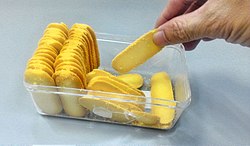 Kue lidah kucing | |
| Type | Cookie |
|---|---|
| Course | Snack, dessert |
| Place of origin | Indonesia |
| Region or state | Nationwide |
Kue lidah kucing (lit. 'cat tongue kue ') is a small Indonesian biscuit ( kue kering ) shaped somewhat like a cat's tongue (long and flat). [1] They are sweet and crunchy. This cookie is a Dutch-influenced cookie due to the historical tie between Indonesia and the Netherlands. [2] In the Netherlands, this cookie is known as kattentong, and ultimately derived from European cat tongue biscuit.
In Indonesia, kue lidah kucing is widely known. This pastry is a special dish in some Indonesian occasion such as Eid ul-Fitr, Christmas and Chinese New Year.
